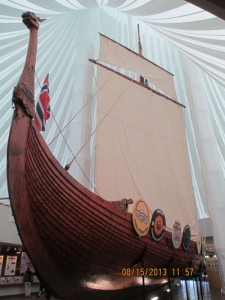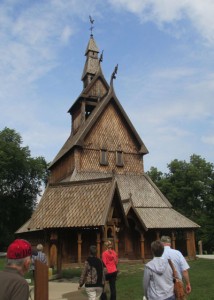Along with the terrible and gruesome loss of life we are witnessing in the Syrian civil war, nothing is more wrenching than people’s loss of home. The land of Syria has been home for people for many thousands of years. Its cities are some of the most ancient in the world, its traditions the richest. And yet, it is being torn apart block by block because of fear and frenzy, revenge and frantic self-defense. This loss of home, this primordial desire to return to our homes, has become an insistent voice in my mind over the past month. It is manifested in my earlier poem “Come Home.” It was amplified in a different way by a recent visit to the Hjemkomst Center in Moorhead, Minnesota, on a trip to visit my daughter’s family.
 “Hjemkomst” means “homecoming” in Norwegian. It is the name of an exact replica of an ancient Viking ship built in the nearby town of Hawley, MN, by Robert Asp, his family, and friends in the late 1970s. The descendant of Norwegian immigrants, Asp was seized by a desire to sail back to Norway in the kind of ship his ancient ancestors had sailed a thousand years ago. Even though Asp died in 1980, members of his family, joined by a Norwegian sailor familiar with these craft, set sail from Duluth, MN, in late Spring, 1982, and made it through storms on the Great Lakes, through the Lackawanna Canal in New York, and on to New York City, from which they sailed to Bergen, Norway, arriving on July 19, 1982. The ship is now housed in a tent-like building — the Hjemkomst Center — alongside the Red River that divides Moorhead from Fargo, ND.
“Hjemkomst” means “homecoming” in Norwegian. It is the name of an exact replica of an ancient Viking ship built in the nearby town of Hawley, MN, by Robert Asp, his family, and friends in the late 1970s. The descendant of Norwegian immigrants, Asp was seized by a desire to sail back to Norway in the kind of ship his ancient ancestors had sailed a thousand years ago. Even though Asp died in 1980, members of his family, joined by a Norwegian sailor familiar with these craft, set sail from Duluth, MN, in late Spring, 1982, and made it through storms on the Great Lakes, through the Lackawanna Canal in New York, and on to New York City, from which they sailed to Bergen, Norway, arriving on July 19, 1982. The ship is now housed in a tent-like building — the Hjemkomst Center — alongside the Red River that divides Moorhead from Fargo, ND.
Not only did Robert Asp have a deep desire to re-connect with a home he had never seen, he wanted to do so in a way that would help him re-enter the history of sea-faring and boat craft that had fed the culture of his people, even into their landlocked pioneer settlements on the prairies of western Minnesota and the Dakotas. As I walked around the ship, I inspected its lapped oak planks, each only an inch thick and riveted to the oak staves forming its hull. According to the video documentary about the boat, it had suffered two gashes on the trip that had imperiled the whole ship, but it had managed to make the crossing nevertheless. At only 76.5 feet long, it was shorter than the boats Columbus had used to find these western lands. The courage and skill in making and sailing the ship was obvious as the wood itself. But the oak, the wood that launched a thousand ships, had held firm. While we live in a time of metals, plastic, and glass, it has been these woods that have housed our lives and carried us over the land and seas, yielding memories that still speak of home, of place, of bonding to a land.
Outside the building is a recreation of an old Norwegian “stave church,” made of pine, redwood, and basswood. It, too, is a replica of the churches built a thousand years ago in Norway, as King Olaf spread Christianity among his people. It, too, was lovingly built by local crafters. Exquisite wood carvings decorate its entrance as well as a the altar installation inside. Built of wood, most of these churches have rotted away, but a few, including this building have survived to speak to us of a heritage as well as a deeper connection of people, land, wood, and faith.
made of pine, redwood, and basswood. It, too, is a replica of the churches built a thousand years ago in Norway, as King Olaf spread Christianity among his people. It, too, was lovingly built by local crafters. Exquisite wood carvings decorate its entrance as well as a the altar installation inside. Built of wood, most of these churches have rotted away, but a few, including this building have survived to speak to us of a heritage as well as a deeper connection of people, land, wood, and faith.
As I emerged from the world of these ancient structures of wood, I was delighted by the sight of a traveling exhibit of the St. Johns Bible in the same building. As I have written earlier, here is one of the most stunning examples of the recovery and preservation of an art and a craft that embodies both human ability and divine transcendence. Always a must see, it was a fitting complement to the woodcraft of ancient Norway.
All of these are forms of “home,” symbols of a harmony of hand and mind, memory and hope. As we crawl toward some kind of resolution of this carnage in Syria, we have to remember the power of this image in our lives.







 Red Clay, Blood River
Red Clay, Blood River